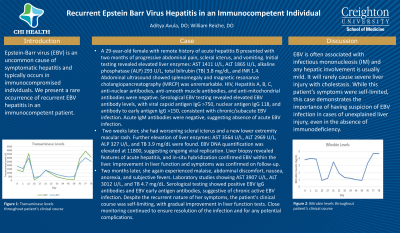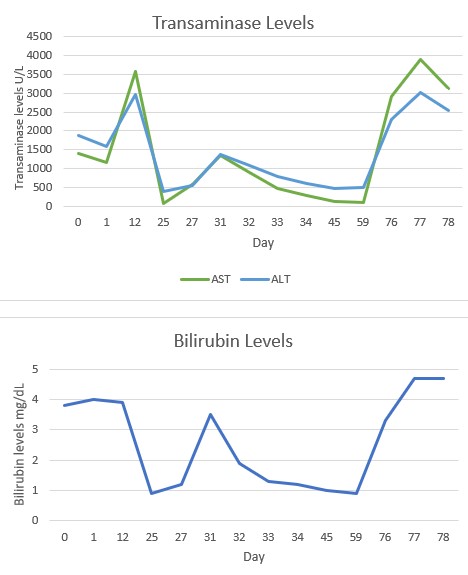Sunday Poster Session
Category: Liver
P1386 - Recurrent Epstein Barr Virus Hepatitis in an Immunocompetent Individual
Sunday, October 27, 2024
3:30 PM - 7:00 PM ET
Location: Exhibit Hall E

Has Audio

Aditya V. Avula, DO
Creighton University School of Medicine
Rochester, MN
Presenting Author(s)
Aditya V. Avula, DO, William Reiche, DO
Creighton University School of Medicine, Omaha, NE
Introduction: Epstein-Barr virus (EBV) is an uncommon cause of symptomatic hepatitis and typically occurs in immunocompromised individuals. We present a rare occurrence of recurrent EBV hepatitis in an immunocompetent patient.
Case Description/Methods: A 29-year-old female with remote history of acute hepatitis B presented with two months of progressive abdominal pain, scleral icterus, nausea, and vomiting. Initial testing revealed elevated liver enzymes: AST 1411 U/L, ALT 1865 U/L, alkaline phosphatase (ALP) 293 U/L, total bilirubin (TB) 3.8 mg/dL, and INR 1.4. Abdominal ultrasound showed splenomegaly and magnetic resonance cholangiopancreatography (MRCP) was unremarkable. HIV, Hepatitis A, B, C, anti-nuclear antibodies, anti-smooth muscle antibodies, and anti-mitochondrial antibodies were negative. Serological EBV testing revealed elevated EBV antibody levels, with viral capsid antigen IgG >750, nuclear antigen IgG 118, and antibody to early antigen IgG >150, consistent with chronic/subacute EBV infection. Acute IgM antibodies were negative, suggesting absence of acute EBV infection. Two weeks later, she had worsening scleral icterus and new lower extremity macular rash. Further elevation of liver enzymes: AST 3564 U/L, ALT 2969 U/L, ALP 327 U/L, and TB 3.9 mg/dL were found. EBV DNA quantification was elevated at 11800, suggesting ongoing viral replication. Liver biopsy revealed features of acute hepatitis, and in-situ hybridization confirmed EBV within the liver. Improvement in liver function and symptoms was confirmed on follow-up.
Two months later, she again experienced malaise, abdominal discomfort, nausea, anorexia, and subjective fevers. Laboratory studies showing AST 3907 U/L, ALT 3012 U/L, and TB 4.7 mg/dL. Serological testing showed positive EBV IgG antibodies and EBV early antigen antibodies, suggestive of chronic active EBV infection. Despite the recurrent nature of her symptoms, the patient's clinical course was self-limiting, with gradual improvement in liver function tests. Close monitoring continued to ensure resolution of the infection and for any potential complications.
Discussion: EBV is often associated with infectious mononucleosis (IM) and any hepatic involvement is usually mild. It will rarely cause severe liver injury with cholestasis. While this patient’s symptoms were self-limited, this case demonstrates the importance of having suspicion of EBV infection in cases of unexplained liver injury, even in the absence of immunodeficiency.

Disclosures:
Aditya V. Avula, DO, William Reiche, DO. P1386 - Recurrent Epstein Barr Virus Hepatitis in an Immunocompetent Individual, ACG 2024 Annual Scientific Meeting Abstracts. Philadelphia, PA: American College of Gastroenterology.
Creighton University School of Medicine, Omaha, NE
Introduction: Epstein-Barr virus (EBV) is an uncommon cause of symptomatic hepatitis and typically occurs in immunocompromised individuals. We present a rare occurrence of recurrent EBV hepatitis in an immunocompetent patient.
Case Description/Methods: A 29-year-old female with remote history of acute hepatitis B presented with two months of progressive abdominal pain, scleral icterus, nausea, and vomiting. Initial testing revealed elevated liver enzymes: AST 1411 U/L, ALT 1865 U/L, alkaline phosphatase (ALP) 293 U/L, total bilirubin (TB) 3.8 mg/dL, and INR 1.4. Abdominal ultrasound showed splenomegaly and magnetic resonance cholangiopancreatography (MRCP) was unremarkable. HIV, Hepatitis A, B, C, anti-nuclear antibodies, anti-smooth muscle antibodies, and anti-mitochondrial antibodies were negative. Serological EBV testing revealed elevated EBV antibody levels, with viral capsid antigen IgG >750, nuclear antigen IgG 118, and antibody to early antigen IgG >150, consistent with chronic/subacute EBV infection. Acute IgM antibodies were negative, suggesting absence of acute EBV infection. Two weeks later, she had worsening scleral icterus and new lower extremity macular rash. Further elevation of liver enzymes: AST 3564 U/L, ALT 2969 U/L, ALP 327 U/L, and TB 3.9 mg/dL were found. EBV DNA quantification was elevated at 11800, suggesting ongoing viral replication. Liver biopsy revealed features of acute hepatitis, and in-situ hybridization confirmed EBV within the liver. Improvement in liver function and symptoms was confirmed on follow-up.
Two months later, she again experienced malaise, abdominal discomfort, nausea, anorexia, and subjective fevers. Laboratory studies showing AST 3907 U/L, ALT 3012 U/L, and TB 4.7 mg/dL. Serological testing showed positive EBV IgG antibodies and EBV early antigen antibodies, suggestive of chronic active EBV infection. Despite the recurrent nature of her symptoms, the patient's clinical course was self-limiting, with gradual improvement in liver function tests. Close monitoring continued to ensure resolution of the infection and for any potential complications.
Discussion: EBV is often associated with infectious mononucleosis (IM) and any hepatic involvement is usually mild. It will rarely cause severe liver injury with cholestasis. While this patient’s symptoms were self-limited, this case demonstrates the importance of having suspicion of EBV infection in cases of unexplained liver injury, even in the absence of immunodeficiency.

Figure: Trend of transaminase and bilirubin levels throughout the patient's disease course
Disclosures:
Aditya Avula indicated no relevant financial relationships.
William Reiche indicated no relevant financial relationships.
Aditya V. Avula, DO, William Reiche, DO. P1386 - Recurrent Epstein Barr Virus Hepatitis in an Immunocompetent Individual, ACG 2024 Annual Scientific Meeting Abstracts. Philadelphia, PA: American College of Gastroenterology.
